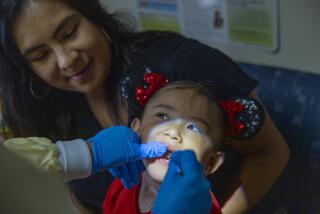Grin and Bare Them
- Share via
Blame it on vanity. Or on baby boomers with too much money and too much riding on first impressions, job interviews and business deals. The fact is, a growing dental specialty is filling people’s needs for capping, covering and whitening their teeth.
Aesthetic dentistry works in three ways: repairing damaged teeth, preventing further damage and improving overall appearance. Dentists achieve this through bonding or with caps. A bleaching process lightens stains.
“Aesthetic dentistry should be quiet dentistry,” says Huntington Beach dentist Stanley Anzis. “No one should be able to tell you’ve had your teeth repaired or whitened.”
It sounds painless, but there are some caveats.
Anzis suggests choosing a dentist through a referral by a friend or colleague who has had similar work done.
“Capped teeth should not have dark lines at the gums,” Anzis says. “Bonding may be slightly visible but only under a bright light.”
Use caution when choosing over-the-counter self-bleaching kits. These whitening products cost far less than a trip to the dentist, but bleaching trays don’t fit everyone.
“Although the peroxide mixtures in these kits are mild, any leakage could cause damage to the gums,” Anzis says.
Whitening toothpastes may contain abrasives that are harmful to gums and could permanently damage enamel. Ask your dentist for suggested brands before trying one of these products.
People think teeth must be bright white to be healthy, but yellow or gray is the natural color for teeth.
“No product or method will make stains disappear totally,” Anzis says.
What Stains Teeth Tooth enamel stains slowly and permanently. The most common surface stains come from tea, coffee or tobacco, but some stains come from the inside out: * Large concentrations of fluoride in drinking water may cause yellowing. * Calcium deficiencies cause chalky white spots, commonly called “headlights.” * The antibiotic tetracycline can turn teeth gray. * The most commonly used filling material, silver amalgam, may cause a chemical reaction that stains surrounding teeth. * Broken teeth can turn brown from blood seeping into the pulp chamber.
How to Get a Bright Smile BLEACHING Hydrogen peroxide is an anti-bacterial and cleaning chemical used in facial cleansers and bleaches. When applied to teeth, a mild peroxide mixture lightens enamel. Using a mixture too strong or too often can damage gums. Whether peroxide is applied in the office or at home, dentists should monitor closely for damage to gums. What to expect: Several treatments required; results may last less than a year. Estimated cost: $300-$600 *
Surface Bleaching Performed in dentist’s office 1. Rubber dam molded over gums to isolate treatment area. 2. Peroxide mixture painted on surface of teeth. Rubber dam removed, peroxide rinsed off; teeth polished. *
Performed at home 1. Dentist sends patient home with peroxide kit; recommended peroxide mixture is swabbed inside bleaching tray. 2. Tray is inserted over teeth; worn for prescribed length of time only. *
Inside-Out Bleaching Peroxide mixture is injected into the root canal and seeps into the tooth. The process, called “walking bleaching,” takes two to three weeks to lighten stains. *
COMPOSITE BONDING Claylike composite mixture molded to chipped tooth and held in place with a liquid bonding agent. *
What to expect: Good for chipped teeth. Better than caps for children with growing teeth; may last for more than five years. *
Cost: $200-$2,000, depending on extent of damage, number of teeth involved. *
1. Mild acid brushed on to make chipped tooth more porous for adhesion. 2. Composite mixture plugged on to chipped area. 3. Mixture sculpted to match original tooth’s shape; once hardened, bonded tooth is bleached to match other teeth. *
CAPS Hard, prefabricated shells cast of porcelain or acrylic are laminated to teeth. Best for teeth not used for heavy chewing. Excellent choice to repair severely chipped teeth or to close gaps. *
What to expect: Resists staining; with proper care may last up to 20 years. *
Cost: $200-$2,000, depending on extent of damage, number of teeth involved. *
1. Small amount of tooth enamel scraped off both teeth. 2. Impressions taken for caps, sent to lab to be cast. Gapped teeth etched with acid; liquid bonding agent applied. 3. Caps attached, fitted for size and comfort; permanently affixed.
Grin Quiz Celebrities are asked to do it all the time: Smile! Some have perfect smiles and some . . . not so perfect. For some tongue-in-cheek fun, match each star with his or her toothsome grin. *
Grin Quiz answers: 1.Julia Roberts, 2.George Bush, 3.Connie Chung, 4.Madonna, 5.Garth Brooks, 6.Tom Hanks, 7.Whoopi Goldberg, 8.Anthony Hopkins, 9.David Letterman, 10.Bill Clinton, 11.Jack Nicholson, 12.Marilyn Monroe. *
Sources: Dental Methods and Procedures, World Book Encyclopedia; Researched by APRIL JACKSON / Los Angeles Times


